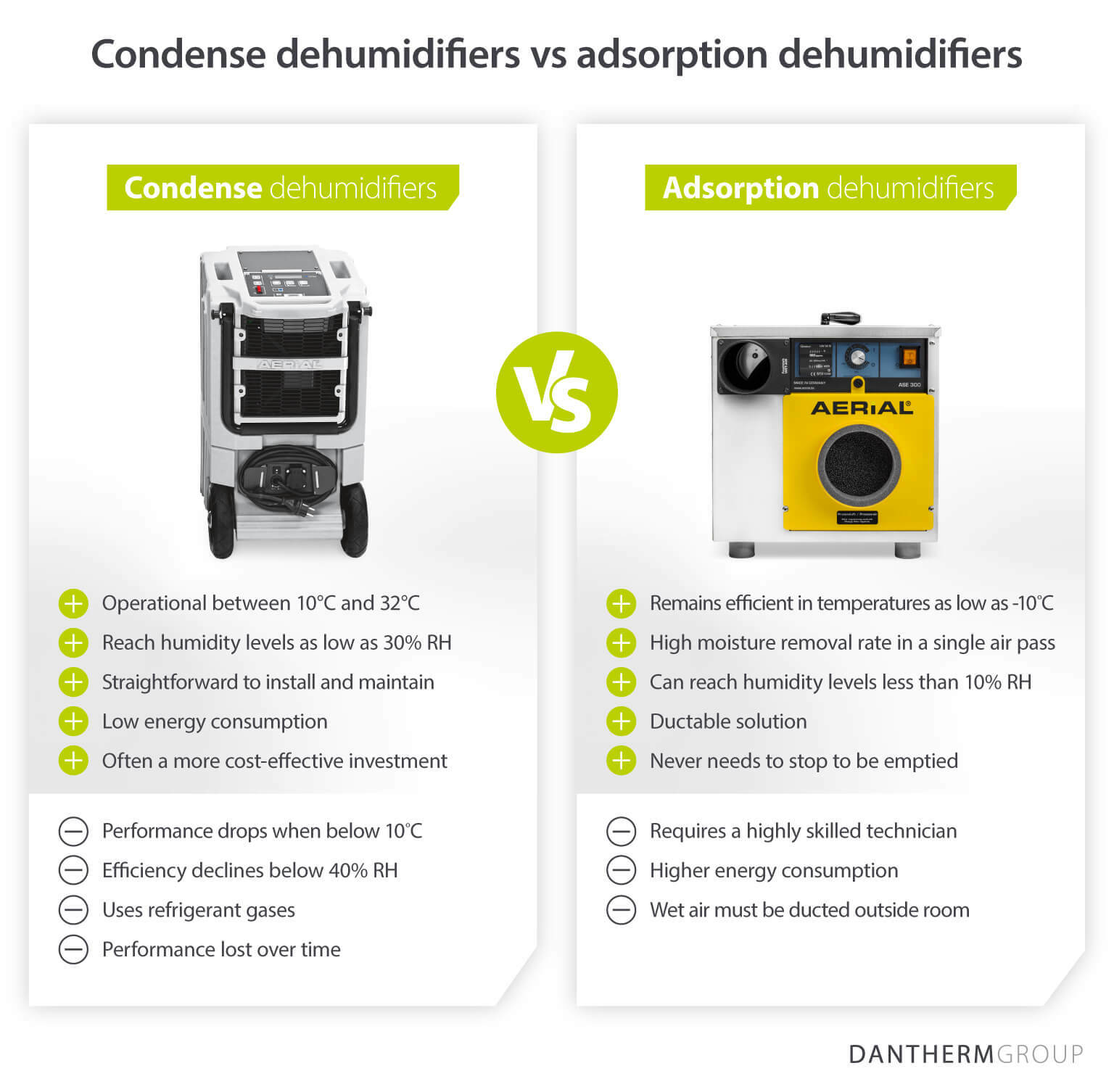Water damage drying: The essential guide

- Home
- Insights
- Humidity control and drying insights
- Water damage drying: The essential guide
In buildings affected by sudden or long-term water damage, restoration works are essential to prevent serious, costly repairs and to protect the health of occupants. Here we cover everything you must know about water damage drying and the equipment needed to carry out these projects.
What can cause water damage?
There are numerous ways water damage can occur to a building. It can be a gradual build-up of drips over weeks and months, or the result of a catastrophic one-off event, such as flooding or a similar natural disaster.

The different types of water damage
As well as the amount of water that has affected a building, the type of water will also greatly influence the cost and duration of a water damage restoration project.
Category 1 (or clean water) from burst pipes or plumbing leaks is the most straightforward to deal with, requiring little or no decontamination as part of the drying process.
Category 2 (grey water) or Category 3 (black water) often comes from long-term standing water or flood events, and requires thorough decontamination work as part of the drying process.
How long does water damage take to show?
The time it takes water damage to become visible will depend on several factors, including the location of the damage, the materials affected and the amount of water.
Clear signs of water damage include:
Visible or standing water
Damp or wet areas on materials
Discolouration on walls or furnishings
Presence of mould and mildew
Rust or corrosion on metals
Warping or cracks in wooden floors
Musty odours in the area
Higher than normal relative humidity in the building
Why is drying water damage important?
If left to spread freely, excess water can have severe ramifications. Furnishings and items can become irreparably damaged. Building structures collapse, resulting in expensive, wide-scale repairs. Breeding grounds for mould form, placing the health of occupants in serious jeopardy.
Addressing water damage as soon as possible is hugely important. The longer it is allowed to progress, the more long-term problems it causes:

How to dry water damage step-by-step
1. Assess the damage
The first step of drying water damage is to assess the extent of the problem. This should be conducted by a trained professional, who will be able to locate the source of the damage, identify all affected areas and plan the scope of works.
Quality leak detection and measurement technology, such as acoustic measuring devices and moisture meters, are vital at this stage to determine where the leaks are and how much of the construction needs to be dried.
2. Introduce preventative measures
Some useful preventative steps at the start of a water damage restoration project include:
Shielding cables and pipes to prevent further damage
Opening windows to allow humidity to escape
Removing sources of bulk water using wet vacs, mops, towels etc. Wet rugs and carpets can also be removed if possible.
Stopping the water supply to the building where needed to minimise further damage
Switching on heating systems to aid the drying process
Salvaging or removing water-damaged items from the affected area
Maximising ventilation by leaving doors open and using air movement where possible
Wearing protective gear where contamination is visible or possible
3. Remove standing, stagnant water
Following a flood or rapid burst pipe, it will be important to use a wet vac or pump to remove the excess water from a room. This greatly reduces the risk of water further ingressing into the layers of the building and allows for water extraction to begin.
4. Extract water from the fabric of the building
Using specialist drying equipment for water extraction can save you valuable time, money and the hassle of removing wet insulation from walls or under floorboards. There are two main drying methods to achieve this: positive pressure drying and negative pressure drying.
Positive pressure drying is where hot, dry air is blown into the layers of structures to force water vapour into the atmosphere, where it is typically captured by refrigerant dehumidifiers. This is often the fastest way to extract water from spaces.
However, this technique is only suitable for well-ventilated or vacant rooms, and should only be performed with HEPA air filtration solutions placed to control the ambient air. This is because positive drying can also exhaust dust, mould and other harmful contaminants into these spaces. Due to these risks, positive pressure drying is not commonly used across Europe, but is still applied in certain areas, such as the United Kingdom.
Instead, negative pressure drying is the safer, healthier approach to removing moisture. Also known as vacuum drying or suction drying, water is sucked out of cavity spaces and pulled through multiple layers of filtration. While this results in slightly longer drying times, it is the best way to protect the health of people on-site and maintain control of the drying environment.
TheAERCUBE® drying system is perfectly placed to meet any form of pressure drying. It is specifically designed to target wet insulation layers with total control, minimising future strip-out and reinstatement work, as well as function as a high-performance dehumidifier.

5. Establish a suitable drying environment
Creating the ideal environment for efficient, effective water damage restoration starts with the right dehumidifiers.
These remove moisture from the air and encourage it out of water-damaged materials and furnishings – gradually eliminating all traces of excess water in the area.
Refrigerant dehumidifiers (a.k.a. condensation dehumidifiers) are capable of fulfilling the needs of most restoration works in a cost-effective, energy-efficient way. Humid air is drawn into the unit and passed over a cold coil. As the water in the air condenses, these water droplets are captured by the system, with dry, warm air pumped back into the room.
However, in especially cold conditions, you may require a desiccant or adsorption dehumidifier. Instead of using condensation, here air is forced over desiccant materials that attract and retain water, with dry air outputted back into the room.
In many cases, desiccant dehumidifiers can speed up the drying process when compared to refrigerant dehumidifiers. However, this greater speed comes at a greater expense, both in terms of energy consumption and operating costs.

While dehumidifiers are the core technology for drying water damage, applying these in combination with other solutions can lead to faster, more successful outcomes:
Water damage fans and air movers
Air circulation is crucial for quicker and better drying results. The use of professional fans and air movers will encourage moisture trapped in building materials and items into the atmosphere, where it can be more efficiently captured by dehumidifiers. Commercial floor dryers can also be useful for speeding up the removal of water on wooden floors, carpets and more.
Any form of ventilation can make a difference in reducing drying times. Even opening a window can be beneficial to raise the air flow.
Heaters
In addition to air movement, warmer temperatures can encourage water evaporation from building materials and furnishings. Using commercial heaters can speed up drying times by forcing water vapour into the air more quickly than a dehumidifier could do on its own.
However, do not use heaters as a substitute for dehumidifiers. Without a dehumidifier in place, the moisture removed from materials by the heaters will linger in the atmosphere, condensing again once it hits cold surfaces.
6. Monitor the drying process
Measurements should be taken throughout a project to keep track of progress and ensure schedules are being met. This will also help identify if any outside parties are interfering with the drying process (e.g. occupants switching off dehumidifiers at night).
The most important measurements to document this process include:
Resistance measurement: Identifies the moisture content in the deeper layers of building materials and insulation
Capacitive measurement: Non-invasive method of locating damp spots and hidden areas of lingering moisture
Humidity and temperature measurement: Tracks the environment to ensure it remains at an optimal level
Today, remote monitoring solutions allow water damage technicians to conduct many of these tasks without having to visit sites in person, saving travel costs and limiting disruption for those living or working at these premises.
7. Disinfect areas where necessary
Finally, and especially in flood damage cases, it is vital that the area is disinfected to prevent mould growth or the spread of germs. This can be supported by the use of drying technology with HEPA filtration, which forces any water through high-quality filters that capture particles as small as 0.3 microns.
Choosing the right drying equipment for your project
While the unique drying needs of every site will demand different solutions, common equipment required to fulfil these jobs efficiently and comprehensively includes:
Leak Detection Equipment
Air Filtration and Purification Devices (HEPA)
Ozone Generators and Ionisation Systems
Condensation and Adsorption Dehumidifiers
Insulation Drying Solutions (Pressure Drying)
Wet vacuums and HEPA Vacuums
Professional fans or air movers
Commercial heaters
Moisture meters and other measurement technology
Remote monitoring technology
Dust Prevention and Removal Solutions
Cleaning and disinfectant equipment
It is important to assess each project independently when selecting what equipment is suitable – the fastest approach may not always be the optimal one:
Using overly powerful technology can be costly and energy-intensive
More powerful units are often large and loud, which may make life difficult for those still living in the building
Older homes or listed buildings may require a more gentle approach to drying to best preserve their more fragile materials
It is critical to select units best suited to the job at hand. Our experts in dehumidifiers and water damage drying equipment will help you select the most suitable solutions for every scenario and guide you to our select dealers and renting companies.
How long does it take to dry water damage?
Water damage restorations can take anywhere from a matter of days to several months to complete. Factors that can influence drying times include:
The amount of excess water and the severity of the damage
The types of materials affected
Outdoor weather conditions
The category of water and risk of contamination
The extent of strip-out work required

How much does it cost to dry water damage?
There is no definitive answer to how much an average water damage restoration claim costs. Projects for domestic properties will vary on the number of rooms affected, and be significantly less costly than those impacting stately homes or listed buildings.
For water damage restoration professionals, ‘hidden costs’ such as travel, routine inspections and labour time can add to the total resources required to conduct these projects. With margins incredibly fine in this industry, it is important to invest in long-lasting, suitably-powered equipment and smart techniques to help you stay profitable from site to site.
For a full breakdown of the costs of water damage drying, and tips to cut spending without compromising quality, click here.
Find the best water damage drying equipment at Dantherm Group
Effective water damage drying starts by selecting the right equipment. At Dantherm Group, our extensive range of specialist drying solutions is engineered to meet the needs of any project with unmatched reliability, efficiency and performance.

From the comprehensive capabilities of the AERCUBE® system, to an outstanding selection of portable dehumidifiers, fans and heaters, we are the one-stop destination to support you on projects of any scale or specification.
Get in touch with an expert today using the form below, or browse our range of dehumidifiers here.
Related products
Featured insights

An in-depth look into how to dry out water damage.

The quick guide to drying out buildings

Save time and money on removing moisture from under the floors
Need help with choosing the right solution? Our team of over 100 climate control experts can assist.
You can also reach out or join the discussion on our Social Media. Check out our LinkedIn page.





